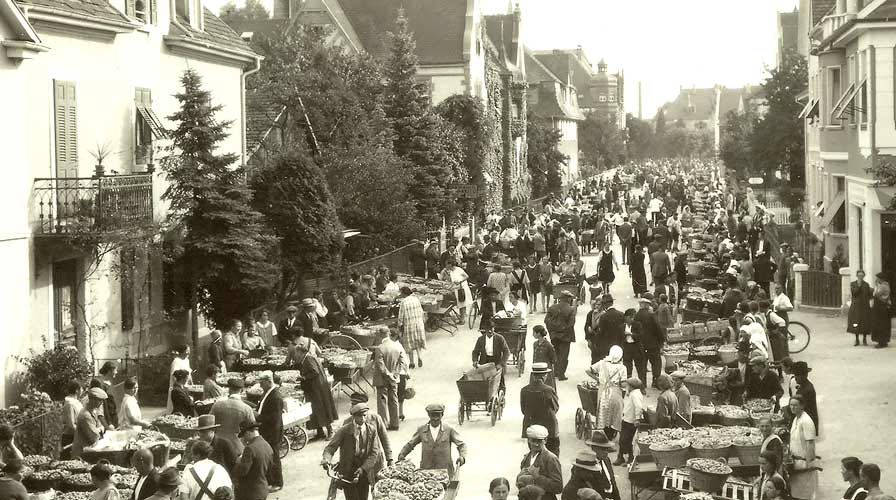Historisches
Die Geschichte der Stadt Bühl lässt sich bis ins 13. Jahrhundert zurückverfolgen.
Bereits im Jahre 1283 wurde Bühl zum ersten Mal urkundlich erwähnt, doch Funde aus der Stein- und Bronzezeit belegen, dass die Region eine wesentlich ältere, sehr bewegte und in vielen Bauwerken immer noch lebendige Geschichte vorweisen kann.
Von der Verleihung des Marktrechts 1403 über die Erlangung des Stadtrechtes 1835 und die Ernennung zur Großen Kreisstadt 1973 hat sich Bühl zu einem dynamischen Wirtschaftsstandort und Mittelzentrum entwickelt.
Diese Entwicklung kann anschaulich und hörbar im Stadtmuseum in der Schwanenstraße erlebt werden.
Zeitpunkte der Bühler Geschichte
Um 1200
Erbauung der Burg Windeck
1283
Älteste gesicherte Nennung des Ortsnamens Bühl: Edelknecht Burkhard von Crutenbach übergibt seine Güter „in banno Buhel“ dem Abt und Konvent des Klosters Schwarzach
1370/71
In einer Fehde des Reinhard von Windeck mit der Stadt Straßburg werden Bühl und die umliegenden Dörfer schwer in Mitleidenschaft gezogen
1403
König Ruprecht von der Pfalz verleiht Ritter Reinhard von Windeck das Marktrecht
1514-1524
Bau der alten Bühler Pfarrkirche St. Peter und Paul (seit 1880 Rathaus)
1582
Ältester schriftlicher Nachweis für die Ansiedlung von Juden in Bühl
1561
Burg Alt-Windeck soll bereits zur Ruine verfallen sein. Spätestens seit diesem Zeitpunkt wohnen die Herren von Windeck in ihrem Schlosshof in Bühl, an dessen Stelle sich heute das Gasthaus „Badischer Hof“ befindet
1592
Mit dem Tod von Junker Jakob von Windeck stirbt das Rittergeschlecht von Windeck im Mannesstamm aus
1622
Im Dreißigjährigen Krieg fallen kroatische Truppen in Bühl ein und legen den Marktflecken in Schutt und Asche
1632-34 und 1643
Schwedische Truppen besetzen Bühl
1689
Im Pfälzischen Erbfolgekrieg wird Bühl ein weiteres Mal fast völlig zerstört
1703-1707
Im Spanischen Erbfolgekrieg wird die Gegend um Bühl erneut Kriegsschauplatz. Unter dem Oberbefehl von Markgraf Ludwig Wilhelm von Baden, dem sogenannten „Türkenlouis“, kann die „Bühl-Stollhofener-Linie“ verteidigt werden
1788
Der Sitz des Amtes Steinbach (vormals Yberg) wird von Steinbach nach Bühl verlegt
1822/23
Bau der Synagoge, der sogenannten „neuen Judenschule“
1835
Großherzog Leopold von Baden verleiht dem Flecken Bühl das Stadtrecht
Um 1840
In Kappelwindeck wird eine ungewöhnlich frühreifende und widerstandsfähige Zwetschgensorte entdeckt, die als „Bühler Frühzwetschge“ vor allem nach dem harten Winter 1879/80 an Bedeutung gewinnt
1846
Bühl erhält Anschluss an die neueröffnete Eisenbahnlinie zwischen Oos und Offenburg
1848/1849
Revolutionäre Umtriebe: Obervogt Josef Häfelin flieht vor den Unruhen nach Baden-Baden. Es kommt zu Ausschreitungen gegen jüdische Einwohner
1856
Die erste eigene Kirche der evangelischen Gemeinde entsteht in einem ehemaligen Brauhaus zwischen Krempengasse und Bühlot. Das Gebäude wird 1969 abgerissen
1873-1876
Bau der neuen katholischen Pfarrkirche St. Peter und Paul
1879-1880
Umbau der alten Pfarrkirche zum Rathaus
1902
Bau der zentralen Wasserversorgung
1919
Gründung der Obstabsatzgenossenschaft (OAG)
1920
Einführung des elektrischen Lichts
1926-1934
Bau der Kanalisation
1927
6. bis 8. August, Bühl feiert sein erstes Zwetschgenfest
1928
Das erste Bühler Lichtspielhaus nimmt seinen Betrieb auf
1933
Im Zuge der nationalsozialistischen Gesetzgebung wird der Bühler Gemeinderat gleichgeschaltet
1934
Eingemeindung von Kappelwindeck
1938
10. November, die Bühler Synagoge wird in der Reichspogromnacht zerstört. Es kommt zu Ausschreitungen gegen jüdische Bürger
1940
22. Oktober, 26 jüdische Bürger aus Bühl werden in das Lager Gurs in den französische Pyrenäen deportiert. Nur wenige von ihnen überleben den nationalsozialistischen Terror
1945
14. April, Einmarsch der französischen Truppen in Bühl
1946
15. September, erste freie Gemeinderatswahlen seit 1933
1971
Eingemeindung von Neusatz und Oberweier
1972
Eingemeindung von Balzhofen, Eisental und Oberbruch
1973
Eingemeindung von Altschweier, Moos, Vimbuch und Weitenung
1973
Bühl wird „Große Kreisstadt“









